Abstract
The paper is devoted to modeling a non-stress linguistic and cultural educational environment, its filling with the peculiarities of the methodological and psychological specifics of the university training foreign languages while transforming the university into the University 3.0. World practice shows that the main innovations are born in the centers of university science, where a large mass of intellectual youth and scientists are concentrated, who are ready to create and present innovative products in the form of dissertations, graduation projects, scientific publications and in the form of finished machines, devices, technologies. The authors consider the importance of modeling an active linguistic and cultural environment of the university in solving the strategic tasks of training foreign languages during innovative educational reforms in one of the leading universities in the Far East of Russia, Pacific National University in Khabarovsk. The research emphasizes the relevance of linguistic and cultural educational environment to the comprehensive personal development of a student in a multidimensional multicultural environment; some examples of selecting and updating electronic educational courses being given. The authors focus their attention on the peculiarities of foreign languages training programs for the correspondence students. They also consider the potential of the lecturers to use the electronic information and educational system to improve their own pedagogical activity.
Keywords: Blended learning, COVID-19, distance learning, electronic educational course, global pandemic
Introduction
Today multicultural interaction occurs in all the spheres of human life, while both the language and the language education are becoming an important tool for mutual understanding and cooperating in a multicultural community. In accordance with the strategy of the European Union 2020, the further liberalizing and quality improving educational services are linked with strengthening the international component (Syomin et al., 2007). “Education is a great motivator and a source of investment” (Asio & Riego de Dios, 2019, p. 126).
In the process of higher education transformation the great role belongs to online and distance learning. Many national and foreign researches advocate the broad-scale implementation of e-learning in practice of higher education (Kaunov, 2020; Ludwig, 2018; Mendel & Trinadtsatko, 2020). “Online education is ubiquitous in the higher education landscape. It is not going away. In fact, it will only grow in prominence....Higher education is adapting to those changing needs, and in the process, it is revolutionizing higher education” (DeBrock, 2018, p. 58).
Modeling a non-stress educational environment implies reduction of cognitive load, which is given by multimedia material. This reduction is achieved by organizing and orienting the material to students in such a way as to optimize their ability to process the material in operative and long-term memory (Janelli, 2018, para. 6).
At the same time, the process of foreign-language training should have a personal-significant character, social value, and contribute to the individual active formation through a system of positive interpersonal relations. In addition, the modern foreign languages training programs turn the Universities’ graduates to professional self-realization and foreign language proficiency level (Grushevitskaya et al., 2003).
In their work “Three generations of distance education pedagogy” Anderson and Dron (2010) define distance education as technologically mediated and thus it is influenced by technological determinism. They consider new developments in the sphere of distance education and mention even the fourth and fifth generations of distance technologies “…that create “intelligent flexible learning” or that incorporate Web 2.0 or semantic web technologies” (Anderson & Dron, 2010, para. 2).
Problem Statement
Thus, we will consider the current problems of foreign languages training programs for correspondence and optional training students in the University transformation period.
The transition of Pacific National University to a new 3.0 level required a complete reorganization of all the structural units, the Department of Foreign Languages included. In this regard, there arises the question of intensifying the students’ independent work.
Not denying the traditional methods, we widely use the personal-oriented technologies and acquaint students with new standards turning any innovation into a “learning” one, and not into a “promising” one. Peters (1967) proposed to consider the phenomenon of distance education not within the framework of traditional education but to analyze it from the point of view of the economic theory of industrialization (p. 19).
Thus, when modeling a non-stress educational environment, we will be able to overcome the negative signs of stress in advance and prevent the occurrence of negative consequences in a timely manner. According to the modern foreign languages training technologies, the student should be fully immersed in the humanitarian linguistic and cultural environment (Chudaikin, 2017).
Following the principle of language immersion, we will create a new type of educational space (the so called linguistic and cultural environment) to integrate and develop the foreign language competencies. The ideas of modeling a non-stress linguistic and cultural environment consistently correlate with the university social environment, the very infrastructure of the university, its material and technical base, international educational and cultural ties, career guidance activities (Labyntseva, 2012, para. 3). In the long run it results in the students` personal development progress and their general professional cultural level.
However, the Department of Foreign Languages sees a number of problems related to the education of correspondence students (different level of language training, low motivation, focusing on special disciplines, insufficient number of training hours allocated to the Foreign Language discipline, etc.) which can be solved only by developing a new conceptual approach to the correspondence form of foreign language training (Barsukova, 2020).
According to the concept of the University foreign languages training, the educational process involves information methods and techniques and also its own electronic courses. The University lecturers are aware that in addition to developing language competencies, their activities should include outreaching the students’ versatile interests, expanding their personal horizons, raising confidence in their own capabilities. Not less important is the introduction of planning and realizing the optional training courses in the educational proceedings.
Research Questions
To study the impact of University’s transmission to e-learning during the global COVID-19 lockdown, the following objectives were set:
- Studying the benefits of Blended learning in combination with personal interaction between lecturers and students.
- Analysing students’ evaluation of online education results in comparison with their expectations.
- Estimating the level of students’ satisfaction with the Electronic English Courses in Pacific National University.
- Collecting and analysing data of students’ survey to investigate the use of new techniques in traditional education.
- Researching the results of the first experiments to illuminate the negative features in e-learning and improve the Electronic Training Course.
- Using the results of the current research in future modelling the non-stress educational environment in emergent life situations like COVID-19 pandemic or global lockdown.
Purpose of the Study
The purpose of the study was to collect data on how the transition to distance learning impacted undergraduate correspondence students taking Englishcourses. The goal was to identify students’ perception of online learning during the COVID-19 pandemic.
Research Methods
To meet the objectives set, the following research methods were used:
- Theoretical methods: in the form of compilation and an analysis of literature on distance and blended learning and education, synthesis, definition of objectives, and modelling.
- A survey was conducted by distributing an online questionnaire to first year correspondence students. They were strongly encouraged to fill out the questionnaire but their participation remained voluntary. The name and other personal information of the study participants were protected. Data gathered from the survey was analyzed with routine statistical software.
Findings
Universities have long experimented with different learning environments to accommodate the needs of their students. During the last decade, a new educational modality called “Blended Learning” has emerged, which combines face-to-face teaching and online teaching and reduces the time spent attending classes. Thus, it provides an enriching experience that combines the benefits of new technologies with face-to-face social interaction (Guillen-Gamez et al., 2020). Online courses are reforming formal education, not only because of their delivery to desktop, laptop, tablet, or smartphone, but students feel more familiar and comfortable with using the Internet (Grubišić et al., 2020).
In 2014, the Agency for Strategic Initiatives on the basis of the platform of the Leadership Development Institute LEADER-ID developed a project called “The Boiling Point”.
The Boiling point is a space for co-working and it unites the representatives of education, science, business and government in order to exchange their experience and develop the new models for both regional and national development. The project is a platform for project leaders meetings to discuss the problems and find their solutions in the field of innovation, business, industry and social entrepreneurship. The Boiling points are designed to promote the intellectual growth of their participants through the current and effective educational formats, develop a favorable environment for startups, and ensure the rapid introduction of new production developments that will change the living standards in Russia for the best (Volodkin et al., 2020).
On May 21, 2019, the University Boiling Point (UBP) started working at Pacific National University.
Due to this, various opportunities for conducting the optional classes are opening in the following formats:
- Innovation boot camp – an intensive multi-day workshop aimed at developing effective business ideas and best practices through independent team projects.
- Hackathon– a marathon of developers, during which specialists from various fields of software development (programmers, designers, managers) work together to solve a specific problem.
- Seminar-Training – a local communication, organized controlled action, ensuring the stability of the chosen individual or group skills to develop. Typically, one or more subject experts are included, which increases the productivity of activity practices.
- Master class– a training (demonstration) format aimed at obtaining and developing practical skills and conducted by a recognized specialist in specific technological equipment, areas of activity, work experience, etc.
- Training factory– training activities close to the production process on specialized equipment located in academic institutions and/or companies aimed at developing the theoretical and practical knowledge of students in a real production environment.
- Business case– a comprehensive method of training aimed at teamwork and finding a solution to a real business problem using theoretical knowledge, financial and mathematical calculations, etc.
In future and even quite recently, Pacific National University leaders are successfully implementing their ideas at the students’ optional courses.
On March 11, 2020, the World Health organization declared COVID-19 a global pandemic. Paying attention to the speed with which COVID-19 spread to all parts of the world, the government of Russia authorized unprecedented social containment measures to stem the tide. These measures required social distancing and the temporary physical closure of educational institutions. Pacific National University (Russia), like all other institutions of higher learning, had to create distance-learning opportunities to enable students to complete the 2019-2020 academic year.
In order to get an adequate and sincere feedback and learn the students` opinions about the already developed innovative electronic courses an anonymous survey was conducted. The data for this study were collected with an online 20-question survey over a 1-month period (June 2020).
The questions were combined into 5 groups: 1. students` evaluation of the Electronic Training Course; 2. students’ perception of academic information in the Electronic Training Course; 3. students’ opinion about network materials; 4. students’ satisfaction with the lectures presented in the Electronic courses; 5. students` opinion about the overall implementation of the e-learning course. 220 students were surveyed. Below there are some diagrams of students’ answers.
Figure 1 is focused on students` evaluation of the Electronic Training Course. The 1st diagram demonstrates that 55 % of the students surveyed are quite satisfied with the course. However 20% of respondents were disappointed by remote training. They explained in comments that personal contact with a lecturer face to face is necessary for better understanding. 10% succeeded in training, while 15% were not fully satisfied.
Commenting their evaluation, students wrote they were depressed by COVID -19 lockdown and had psychological difficulties in coping with the situation in whole, not only with the course.
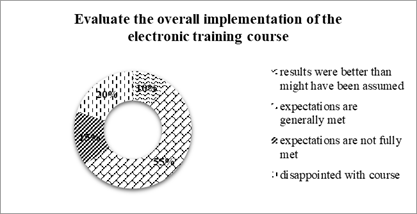
Figure 2 is focused on students’ evaluation of academic information in the Electronic Training Course. 5% and 10 % of students in the 2nd diagram were disappointed by remote training, the other 70 % evaluate the course materials excellently.
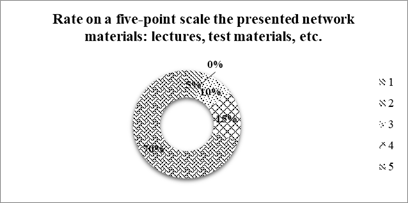
Figure 3 shows students’ opinion about network materials presented in the course. Most questioned respondents consider the materials to be very informative and vapidity free (55 %).
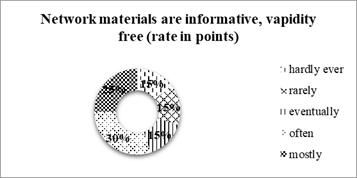
Figure 4 demonstrates students’ satisfaction with the lectures presented in the Electronic courses. 60% of respondents evaluate the conception of lecture material as very effective.
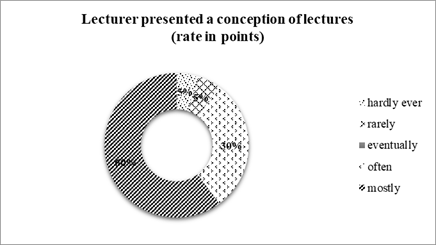
Figure 5 demonstrates highly positive feedback from students engaged in e-learning. All surveyed e-learners are satisfied with the Electronic Training Course.As we know, students’ satisfaction is an important factor for successful e-learning adoption and effective outcome. The students commented that they were fully satisfied with the lecturers’ supportiveness, professional behaviour and network materials presented in the course.
The study showed that the lecturers’ performance significantly influences the students’ evaluation of the e-learning course. Similarly, access to technology is one of the most important factors influencing student satisfaction.
As we know some foreign students are obliged to continue remote studying because of COVID-19 pandemic and closed borders.
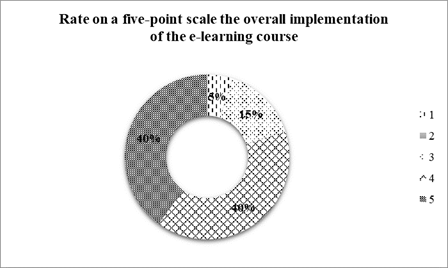
An analysis of the diagrams data shows that most respondents approve of the quality of the electronic course developed and are fully satisfied with the possibility of continuous access to training materials. In addition, the students want to be provided with some optional foreign languages courses. However, the students are against completely abandoning the classroom classes.
Conclusion
7.1. It is significant that it is linguistic and cultural communication that correspondence and distance students catastrophically lack.
7. 2. The experience gained is unique. It requires the further research and analysis. To a certain extent, the present study represents a first step in this direction.
7. 3. The questionnaire “Assessment of a student satisfaction with the quality of the course “Foreign language for the correspondence department”” shows that the educational process within the university is carried out due to the live contact of the lecturer and the students.
7. 4. Offering adequate replacement in virtual learning is not possible.
7. 5. It is so important to preserve values, emotions, that is, a certain linguistic and cultural environment that is inherent in education by definition, when replenishing electronic content.
7. 6. Thinking through modeling the linguistic and cultural educational environment in the new digital reality greatly contributes to solving the indicated problems.
Most students fully or rather agree on the usefulness of electronic informative system in the educational process. They also appreciate the Electronic Information System educational process forbetter mastering the discipline, independent working (promoting self-organization and self-control) (Volodkin et al., 2020).
The research shows that the Department of Foreign Languages makes its best to carry out the first stage of modeling a non-stress linguistic and cultural environment. The authors will continue their investigation in the direction chosen to excite a steady positive interest not only in the language being studied, but also in the unchanged universal human values.
References
Anderson, T., & Dron, J. (2010). Three generations of distance education pedagogy The International Review of Research in Open and Distance Learning, 12(3), 80-97. DOI:
Asio, J. M. R., & Riego de Dios, E. E. (2019). The college students’ perspective on what an educator well-qualified. Journal of Pedagogical Research, 3(3), 126-138. DOI:
Barsukova, N. V. (2020). Student as a responsible subject of the educational process. Ivzestia of Volgograd State Pedagogical University, 3(146), 20-23.
Chudaikin, A. M. (2017). Pedagogical approach to the problem consideration of students’ stress tolerance. Actual pedagogical problems: Materials of VIII Int. Sci. Conf. (Buky-Vedy), 166-168.
DeBrock, L. (2018). The New Face-to-Face Education. Educational Studies Moscow, 4, 44-59. DOI:
Grubišić, A., Žitko, B., Stankov, S., Šarić-Grgić, I., Gašpar, A., Tomaš, S., Brajković, E., Volarić, T., Vasić, D., & Dodaj, A. (2020). A common model for tracking student learning and knowledge acquisition in different e-Learning platforms. Journal of e-Learning and Knowledge Society, 16(3), 10-23.
Grushevitskaya, T. G., Popkov, V. D., & Sadokhin, A. P. (2003). Basics of intercultural communication. UNITY-DANA.
Guillen-Gamez, F. D., Mayorga-Fernández, M. J., & Del Moral, M. T. (2020). Comparative research in the digital competence of the pre-service education teacher: face-to-face vs blended education and gender Journal of e-Learning and Knowledge Society, 16(3), 1-9.
Janelli, M. (2018). E-Learning in Theory, Practice, and Research. Educational Studies Moscow, 4, 81-98. DOI:
Kaunov, A. M. (2020). Development of the creative potential of students with the use of digital information-logical models in project education. Ivzestia of Volgograd State Pedagogical University, 3(146), 36-40.
Labyntseva, I. S. (2012). The attitude of students with different levels of educational activity to future profession. Izvestia of Southern Federal University, 10(135), 226-231.
Ludwig, S. C. (2018). Higher Learning: Lessons from an Online Advocate. Educational Studies Moscow, 4, 167-187. DOI:
Mendel, V. V., & Trinadtsatko, O. A. (2020). Aspects of the usage of information and computer technologies in the educational process. Modern problems of Science and Education, 2. DOI:
Peters, O. (1967). Distance education and industrial production: a comparative interpretation in outline. http://www.c3l.uni-oldenburg.de/cde/found/peters67.htm
Syomin, N. V., Artamonova, Y. D., & Demchuk, A. L. (2007). Academic mobility in Russia: guidelines and regulations. MSU.
Volodkin, P. P., Umanets, I. F., Lazarev, V. A., Panchuk, N. N., & Filatova, O. A. (2020). Creating an on-line learning system at Pacific National University.Sociology, 1, 97.
Copyright information

This work is licensed under a Creative Commons Attribution-NonCommercial-NoDerivatives 4.0 International License.
About this article
Publication Date
02 December 2021
Article Doi
eBook ISBN
978-1-80296-117-1
Publisher
European Publisher
Volume
118
Print ISBN (optional)
-
Edition Number
1st Edition
Pages
1-954
Subjects
Linguistics, cognitive linguistics, education technology, linguistic conceptology, translation
Cite this article as:
Umanets, I., Barsukova, N., Vorobeva, I., & Ostapenko, A. (2021). Modeling A Non-Stress Linguistic Environment For University Students During The Covid-19 Pandemic. In O. Kolmakova, O. Boginskaya, & S. Grichin (Eds.), Language and Technology in the Interdisciplinary Paradigm, vol 118. European Proceedings of Social and Behavioural Sciences (pp. 910-918). European Publisher. https://doi.org/10.15405/epsbs.2021.12.110

